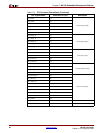
ML310 User Guide www.xilinx.com 33
UG068 (v1.01) August 25, 2004 1-800-255-7778
Board Hardware
R
The three GPIO signals configured as outputs only are used as control signals that allows
the user to read/write the LCD character display in conjunction with the eight LCD data
signals defined earlier in Table 2-7. Please review the AND491GST LCD display data sheet
located on the ML310 CDROM for more detailed information.
Table 2-8 shows the control signal connections for the GPIO LCD from the FPGA to U33.
CPU Debug and CPU Trace
The ML310 board includes two CPU debugging interfaces, the CPU Debug (J12 header)
and the Combined CPU Trace and Debug (P8 mictor) connector.
These connectors can be used in conjunction with third party tools, or in some cases the
Xilinx Parallel Cable IV, to debug software as it runs on the processor.The PowerPC
TM
405
CPU core includes dedicated debug resources that support a variety of debug modes for
debugging during hardware and software development. These debug resources include:
• Internal debug mode for use by ROM monitors and software debuggers
• External debug mode for use by JTAG debuggers
• Debug wait mode, which allows the servicing of interrupts while the processor
appears to be stopped
• Real-time trace mode, which supports event triggering for real-time tracing
Debug modes and events are controlled using debug registers in the processor. The debug
registers are accessed either through software running on the processor or through the
JTAG port. The debug modes, events, controls, and interfaces provide a powerful
combination of debug resources for hardware and software development tools. The JTAG
port interface supports the attachment of external debug tools, such as the ChipScope
TM
Integrated Logic Analyzer, a powerful tool providing logic analyzer capabilities for signals
inside an FPGA, without the need for expensive external instrumentation. Using the JTAG
test access port, a debug tool can single-step the processor and examine the internal
processor state to facilitate software debugging. This capability complies with the IEEE
1149.1 specification for vendor-specific extensions and is, therefore, compatible with
standard JTAG hardware for boundary-scan system testing.
(1)
CPU Debug Description
External-debug mode can be used to alter normal program execution. It provides the
ability to debug system hardware as well as software. The mode supports multiple setting
breakpoints, as well as monitoring processor status. Access to processor resources is
provided through the CPU Debug port.
(2)
Table 2-8: GPIO LCD Control Signal Connections from FPGA to U33
UCF Signal Name
XC2VP30 Pin
(U37)
Schem Signal
Name
LVC244
Buffer (U33)
LCD I/F
(J13)
FPGA_LCD_E C21 FPGA_LCD_E 13 6
FPGA_LCD_RS J17 FPGA_LCD_RS 11 4
FPGA_LCD_RW H17 FPGA_LCD_RW 15 5
1. http://www.support.xilinx.com/ PowerPC Architecture - Debug (JTAG, Trace), Sept. 12, 2002
2. Virtex-II Pro Platform FPGA Documentation - Volume 2(a): PPC405 User Manual, March 2002 Release, p. 537.


















